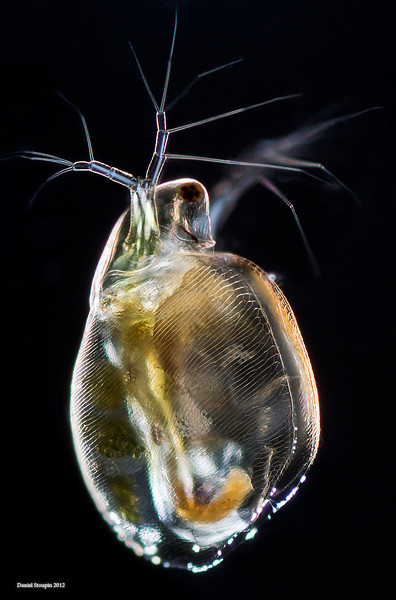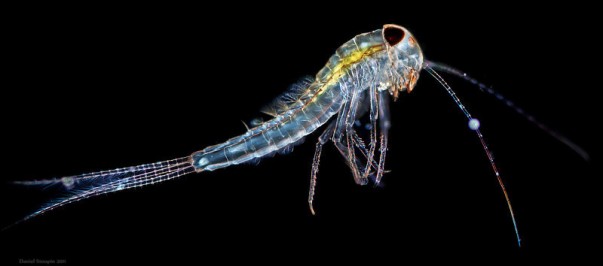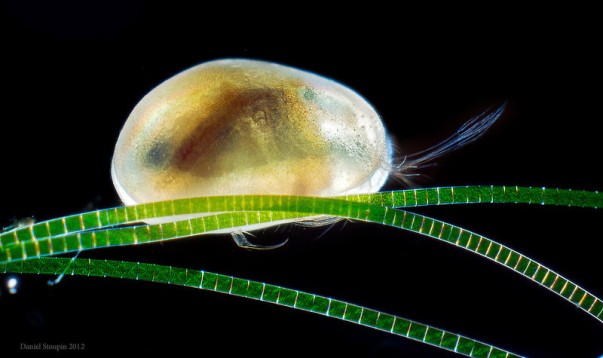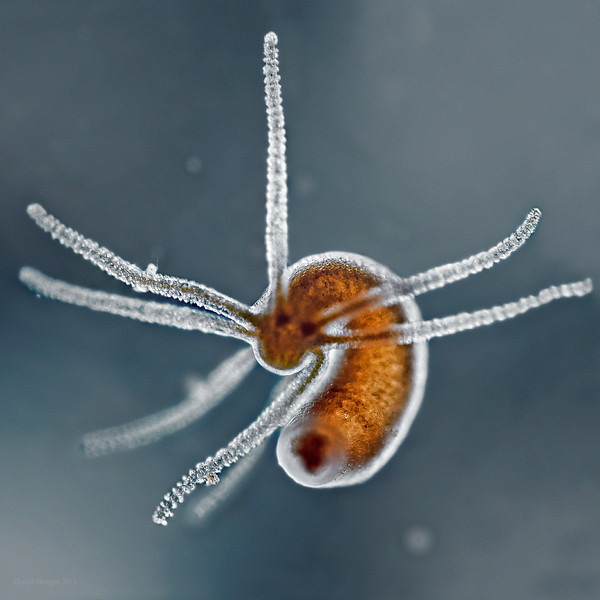While a tablespoon of pond water might look quite devoid of life, a closer look reveals quite the opposite.
Though they may be difficult to spot with the naked eye, that doesn’t mean they’re not important or amazing. Here are some of the amazing critters shown in that video and some interesting facts about each.
Water Flea

Though you may be tempted to call them “little bugs,” these are in fact crustaceans, just like crabs and lobsters.
We rely heavily on these little things in our research, as we’ve described in previous posts. Most water fleas reproduce asexually though successive generations of clones, while occasionally reproducing sexually. This interesting life cycle is known as cyclic parthenogenesis, and is one of the main reasons they are useful for scientific research—it’s relatively easy to breed genetically identical colonies. Another bonus for us is that they’re transparent, so we can easily see what’s happening inside when we expose them to nanoparticles.
Volvox Algae

This is a colony of tens of thousands of volvox algae cells. So beautiful! The cells that make up the outside of the sphere each have tiny eyespots to detect light. These eyespots are especially well-developed on one end of the sphere, which allows the colony to propel itself toward light using its multitude of tiny propeller-like flagella. Scientists are hard at work untangling the genetic basis for how these external cells work their magic.
Mayfly Nymph

Mayflies are insects that live in the water for most of their lives! Crazy! During this immature, freshwater stage, the mayflies are known as nymphs. In their adult stage, they emerge from water with the sole purpose of reproduction. They have from a few hours to a few days to carry out this task before they die.
I became particularly familiar with adult mayflies as I grew up near the shores of Lake Erie. A particular mayfly species (hexagenia) emerges from the lake in enormous numbers and can reach such densities that dead mayflies cause roads to be slippery to drive on.
Ostracod

These are another tiny crustacean. Like the water flea above, they serve as an important source of food for small fish. Unlike the water flea however, some ostracods can attack animals much larger than themselves by attacking in groups!! These things can kill fish! What amazingly cooperative creatures!
Hydra

Coming in first in the “awesome name” category, these little radially symmetric creatures can regenerate entire limbs when they are injured or cut off! You’d better believe that scientists are very interested in the details of how this happens. Imagine humans being able to do this kind of thing!
Bryozoa

These are animals! Like so many of their tiny friends, they are filter feeders. Waving those beautiful fans known as lophophores through the water, they collect floating food bits and direct them toward their centrally located mouths. They grow together in beautiful colonies, and some species can even move around cooperatively, just like snails.
Conclusion
Not only are these “hidden” lifeforms full of beauty and scientific research value, but each also plays a critical role in their ecosystem. So, when we investigate how nanoparticles interact with little water fleas, it’s not just because they are transparent and can be grown in genetically identical colonies—two things that make them excellent scientific “model systems.” While we are primarily interested in making big conclusions that the nanotechnology industry can use to make their products benign to all forms of life and also wonderfully useful, there are other pleasures that we derive from this research. It’s nice to know that the knowledge we generate can also be used to protect these beautiful and important creatures that are hidden right before our eyes.
Further Exploration:
Comparing Sizes of Microorganisms activity
The Variety and Roles of Microbes
